My first round of experimenting has produced some good results using the Van de Graaff generator. However I felt that it was capable of producing better prints if the machine/process was refined or modified. One of the main problems I was having was caused by the plasma glow that’s emitted by the machine. There were a number of places that this was happening, the most problematic was around the tip of the electrode as this was interfering with the print itself. One of the other places I noticed it happening was around the length of cable from the sphere to electrode, this is most likely due to insufficient insulation around the cable itself. This could result in losing some of the charge to the surrounding atmosphere which would mean less voltage is able to reach the coins. This could also have a dangerous side effect as the plasma surrounding the cable could be capable of transferring the charge to surrounding objects.
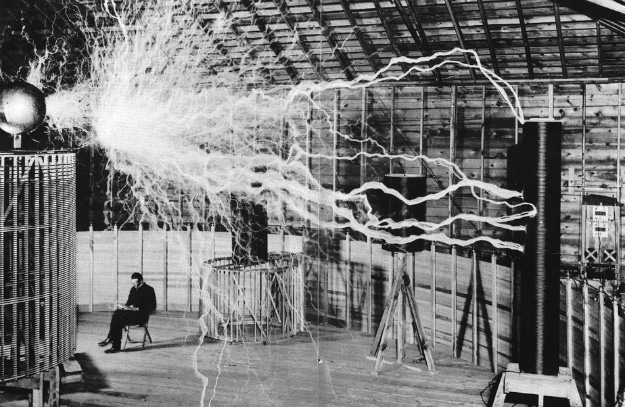
I read through a Nikola Tesla paper from the Scientific American in March 1934, in the paper he mentioned that; “Any device depending on static electricity carried by a belt will fail in damp weather and will have to be operated in a closed space in which the air is properly conditioned.” This could indicate that the plasma glow I noticed in my experiments was worsened by moisture in the air. Also as I’m working in a photographic dark room with a hot tap running for the Stop bath, this could in effect be increasing the overall humidity in the room.
In another section of the paper Tesla mentions; “Most people, and not a few electricians, will think that very long and noisy sparks are indicative of great energy, which is far from being the case. An impressive display of this kind, at several million volts, can be readily obtained with any wide leather or fabric belt in dry weather.” This quote further reinforces the requirement of dry weather for successful experiments. The point about long and noisy sparks not having the greatest energy is worth noting too.
From my understanding of Tesla’s findings, the sphere at the top of the generator stores the static electricity created by the belt and comb part of the generator. The output from the sphere will never be greater than the input from the generator. Although as the sphere stores electricity a bigger sphere should be capable of storing more power. Which in turn would allow it to discharge a larger charge than a smaller sphere.
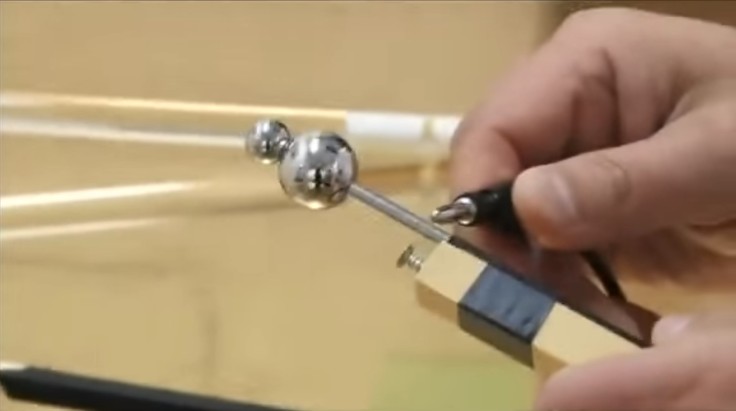
I also remembered that in Sugimoto’s video, one of the electrodes he uses has two small spheres attached to the end. This could be a way of storing some of the charge at the end of the cable, which could in turn provide a more powerful discharge.
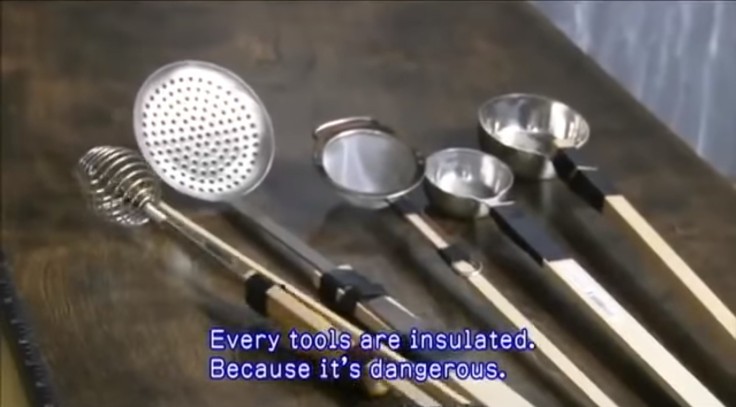
Another snapshot of Sugimoto’s video shows the array of different items he uses as electrodes. The shape and thickness of the metals in the different utensils will have an effect on how the electricity is discharged.
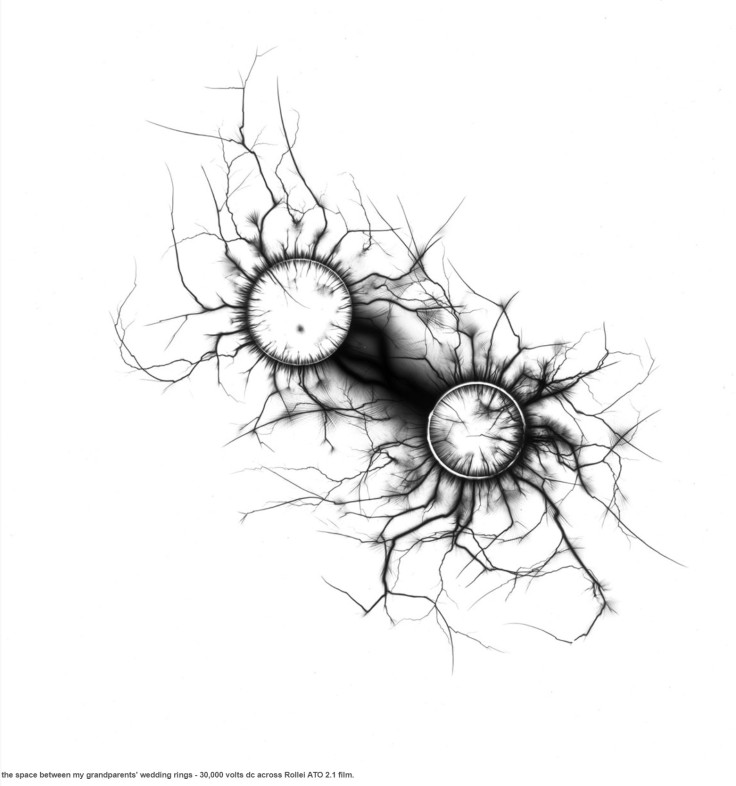
In an interview with the artist Sean O’Connell he is quoted as saying; “What you see in the images are electrical arcs, ionised trails of light, channelled through each ring, directly exposing onto traditional photographic emulsion,” O’Connell writes, describing the process. “The images are not presented here as an aura or the motion of the aether, but simply as excess electrical energy trying to find a way to ground as fast as possible – like a ball rolling down a hill – potential energy naturally seeking out the lowest place.”
His reference to the excess energy trying to find ground like a ball rolling down a hill made me realise, you could possibly control or influence how the electricity flows through the objects. The image above for instance could be created by having a charged electrode attached to one of the rings, while an earthed cable attached to the other. The electricity from the charged electrode will be drawn towards the grounded ring leaving an imprint of the two bonded together with arcs of electricity.
My previous experiments have all given results similar to the imprint on the left above which was made with a key ring. The electricity flowing through the key ring is displayed as a fuzzy sort of hair surrounding the outer edge. Although this does look interesting it’s not quite how I had pictured it, In comparison to O’Connell’s prints it almost resembles a longer exposure, albeit with smaller forks of electricity. The print on the right is one of Sean O’Connell’s, which is closer to how I want the electricity to look in mine. I think the difference between the two, (other than different machines and techniques) is the duration of the exposure. In my process I turn the generator on and allow the charge time to build, then move the electrode over the object until it discharges. The time it takes for me to bring the electrode close enough to discharge and move away is additional time that the electricity is having an effect on the object/paper.
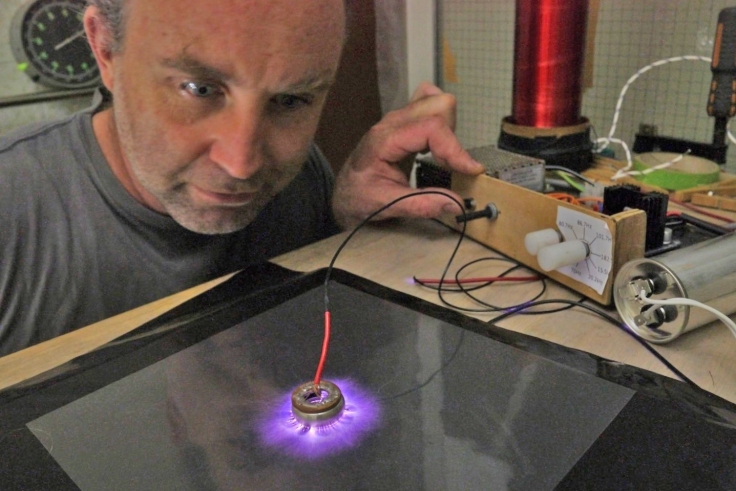
O’Connell’s machine and set up is largely different. In this image it looks like the cable is fixed directly to the object, so he is able to simply flick a switch to transfer the voltage to the object. Along with all the other wiring and equipment in his process, this is slightly more complex than I had in mind. However I could utilize part of this technique for my process. If I had an electrode attached to the coin I was printing and the other end attached to nothing. I could wait for the charge to build in the Van de Graaff sphere then connect the free end of the cable to the sphere. This would transfer the voltage from the sphere, along the cable and through the object being printed. This technique should eliminate any plasma glow as all the electricity is kept well away from the photographic paper until the exact moment of exposure. As well as providing more control over duration of exposure and which parts of the coin were exposed to the electrode. I also noticed that it appears as if O’Connell has added some extra insulation (red electrical tape) around the wiring that will be closest to the paper/film, this could be another way of reducing plasma.
I found an interesting quote from a Vice article about Sugimoto’s work; “He then began firing off high-voltage electrical charges indirectly onto film.” The mention of the word ‘indirectly’ made me question whether Sugimoto was discharging his Van de Graaff onto the film as I had been doing. Or if he had been directly discharging to the copper/brass sheet underneath the film, which would in effect capture the path of the electricity through the metal sheet.











Leave a comment